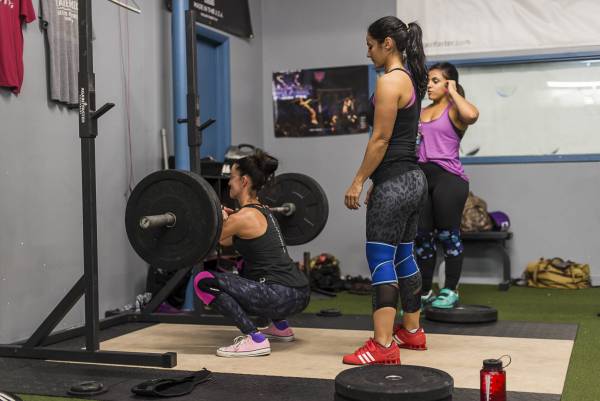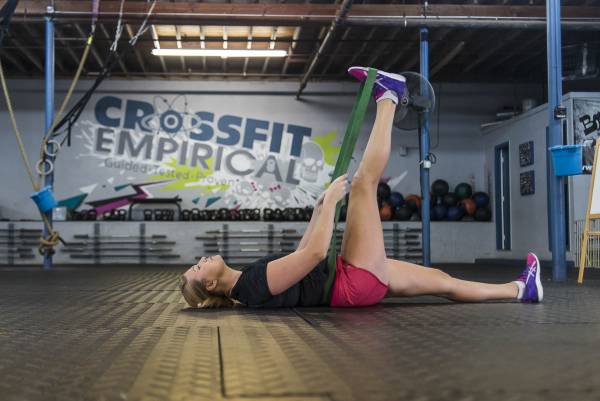Women, does your hormone cycle affect the intensity, difficulty, and quality of your workout? Would you be interested in learning why this happens, how you can maximize your training goals and reduce incidence of injury by learning how your hormone cycle affects you?
It is understood that the female athlete triad includes three distinct and interrelated conditions that affect you and your performance as a female athlete:
- Eating Disorders – Obsessive eating or calorie counting; poor nutrition and the desire to restrict caloric intake, leading to athletic fatigue and decreased performance
- Amenorrhea – Irregular menstrual flow or complete absence of menses for six or more months. (Of note, this symptom is commonly unreported among coaches and athletes.)
- Osteoporosis – Nutritional deficiencies may lead to reduced bone mineralization and increased incidence of fracture risk (stress fracture being the most common).
In this article, we will focus on the hormone cycle as it pertains to physical performance in female athletes in non-sports-specific terms. The goal is to address metabolic concerns, such as:
- Which energy systems are most taxed during the cycle
- When during the cycle that maximal loading is safest
- When it is ideal to add in de-loading time during your training program
By examining the hormone cycle, we can discover ways to make you faster, stronger, and more resilient to injury. This will have positive training effects and increases the potential for setting personal records, either individual or team-based.
First, Some Perspective
Whether we like it or not, there is an unchecked societal pressure for the “ideal” body type that fosters the development of decreased self-esteem, as well as issues of negative body image and the desire to lose weight for sport. This can manifest during the high school years and become intensified during collegiate-level sports, especially where peer-pressure or scholarship money is involved. From here, female athletes become susceptible to the triad.
The prevalence of the female triad is unknown. A 1993 article in Medicine and Science in Sports and Exercise reported:
- Eating disorders in 15-62% of female collegiate-level athletes
- Occurrence in 3.4-66% of female athletes studied
- 60% of female athletes were classified as “at risk” (n = 669)
A 2010 study published in International Journal of Sport Nutrition and Exercise Metabolism looked at overall health in sport in elite female athletes, ages sixteen to 42. 44 elite endurance runners (n=44) participated in a cross-sectional study, and n=7 of those participated in a longitudinal study that measured the correlation between low bone density mineralization, menstrual status, training volume and disordered eating.
“Your cycle lasts roughly four weeks. It would serve you as an athlete, personal trainer, or coach to design programs with this in mind.“
According to the study, 34.2% of these runners had low bone mineral density (as measured at the lumbar spine) and osteoporosis was prevalent in 33%. 15.9% of the sample was determined to have menstrual dysfunction, disordered eating, and lowered bone mineral density.
Science Refresher
If you’re a little rusty on the hormone cycle, here is a quick video that gives you the rundown and will make the rest of this article less confusing:
Take Charge of Your Cycle
If we know the menstrual cycle and dietary intake have a significant impact on overall performance, how then can we influence the female cycle to maximize performance?
Becoming aware of your personal cycle is a great place to start. Not only does it serve as a barometer for normalcy, but it can help to identify if your athletic performance is conflicting with your body’s natural patterns. Maybe you are having a great training week, only to suddenly tank unexpectedly. Maybe there’s a not-so-unexpected reason for it if you look into your body.
First step: Know your cycle. The 28-day cycle is a statistical average. In reality, some women are under this at around 25 days, while others can go over 31 days.
Phase Overview
Here, we will discuss each individual phase of the menstrual cycle, coupled with nutritional strategies and exercise programming that will maximize results and minimize risk for injury.
The Follicular Phase: Ingest Carbs and Train Harder
This phase lasts from day zero to fourteen. It is identified with a higher-than-normal tolerance for pain, as well as greater force-generation capacity during lifting and training. You are best served to focus on training progress during this time.
“There are peak times of metabolic activity where strength gains should be attempted, and there is a reduction phase where it is wise to de-load and let the body recover.“
Also of note, your body trends toward using more carbohydrates at this phase as a fuel source. Meaning, you can proceed with more intense resistance and power training that will deplete your muscle glycogen stores. Ultimately, you can train through tough pain and go stronger for longer.
The Ovulation Phase: Attempt Your Personal Best
This phase occurs around day fourteen. Your relative strength levels will remain elevated and your ability to generate force will be sustained. According to research in the Journal of Physiology, this would be the ideal time for you to attempt personal records.

That being said, it would be wise to note that this phase also elevates your risk for injury. During this phase, the concentration of estrogen elevates, which can interfere with collagen synthesis and neuromuscular control. The American Journal of Sports Medicine reported that ACL injuries were four to eight times higher than at other times during the cycle.
This means you are able to train hard, but adequate form must be adhered to unless you feel like getting injured and spending some time on the bench. You may also experience a slight increase in your appetite that coincides with your increased metabolic activity. It would be prudent to add balanced protein, carb, and fats. Recall that your insulin sensitivity is declining, so listen to your body and respond to your best fuel source accordingly.
The Luteal Phase: Reduce Exercise Intensity and Lose Fat
This cycle lasts from day fifteen to 28. Here, you may be fighting an upstream battle when it comes to your athletic intensity and your output may not match overall performance. During this phase, your body trends toward higher-than-normal temperatures (a few degrees), which can alter cardiovascular output. You are less efficient during exercise and will fatigue sooner than normal. Bummer!
It is at this phase that PMS, or pre-menstrual syndrome, may begin. This may dampen your ability to comfortably participate in activities that favor high-intensity-interval training due to excessive water retention. If you are struggling through PMS, you may consider opting for low impact exercise, such as yoga, or taking this time to work on stretching and balancing exercises.

Metabolically, this is the point that trends toward using fat as a relative fuel source. In terms of athletic output, you would be wise to participate in reduced-intensity cardiovascular training coupled with moderate levels of strength-training – any athletic activity that promotes fat utilization over glucose utilization.
Relative to insulin-sensitivity, this phase will be your lowest. While you will be craving increased carbohydrate sources, your serotonin production will also be reduced. This can increase irritability and you may find eating carbs helps, as it promotes serotonin release. Just be careful not to overdo it. You may want to consider lower calorie options that will keep you satiated and promote fat burning.
Menstruation: Transition Back to Higher-Intensity Workouts
Water retention and PMS symptoms decrease as the body normalizes. This marks the time you can resume higher intensity and strength-training loads as you transition back into the follicular phase.
“Becoming aware of your personal cycle is a great place to start. [I]t can help to identify if your athletic performance is conflicting with your body’s natural patterns.“
The metabolism is still on the decline as insulin sensitivity slowly increases. You would be wise to adopt a diet that is moderate, but not too high in carbohydrates.
Finally, during the transition back to the follicular phase, an increase in carbohydrates is desirable. It will aid in providing the requisite energy for lean muscle mass development and reduce non-lean mass gains.
Hormone Recap
The hormone rollercoaster isn’t as scary as we want to make it out to be. Your body goes transitions from a predominantly carbohydrate to fat utilization fuel source. There are peak times of metabolic activity where strength gains should be attempted, and there is a reduction phase where it is wise to de-load and let the body recover.
Your cycle lasts roughly four weeks. It would serve you as an athlete, personal trainer, or coach to design programs with this in mind.
Check out these related articles:
- Women Are Not Small Men – Essential Info for Female Athletes
- Is My Birth Control Stopping My Progess at the Gym?
- What Women Need to Know About Growth Hormone
- What’s New On Breaking Muscle Today?
References:
1. Bolton, J. G., S. Patel, J. H. Lacey, & S. White. A prospective study of changes in bone turnover and bone density associated with regaining weight in women with anorexia nervosa. Osteoporos. Int. 16:1955–1962, 2005.
2. Byrne, S., & McLean, N. Elite athletes: effects of the pressure to be thin. J. Sci. Med. Sport 5:80–94, 2002.
3. Clark, S. “The Female Triad and Female Lifters” Accessed February 14 2015.
4. Greer, F. R. & N. F. Krebs. Optimizing bone health and calcium intakes of infants, children, and adolescents. Pediatrics 117:578–585, 2006.
5. Horvath, P. J., C. K. Eagen, N. M. Fisher, J. J. Leddy, & D. R. Pendergast. The effects of varying dietary fat on performance and metabolism in trained male and female runners. J. Am. Coll. Nutr. 19:52–60, 2000.
6. Lauder, T. D., S. Dixit, L. E. Pezzin, M. V. Williams, C. S. Campbell, & G. D. Davis. The relation between stress fractures and bone mineral density: evidence from active duty Army women. Arch. Phys. Med. Rehabil. 81:73–79, 2000.
7. Nichols, J. F., M. J. Rauh, M. J. Lawson, M. JI, & H. S. Barkai. Prevalence of the female athlete triad syndrome among high school athletes. Arch. Pediatr. Adolesc. Med. 160:137–142, 2006.
8. Placzek, J.D & Boyce, D.A. Orthopeadeic Physical Therapy Secrets: Your Physical Therapy Questions Answered by Experts You Trust (2nd Ed). Philadelphia, PA: Elsevier Mosby, 2006.
10. Pollock, N., Grogan, C., Perry, M., Pedlar, C., Cooke, K., Morrissey, D & Dimitriou, L. Bone-Mineral Density and Other Features of the Female Triad in Elite Endurance Runners: A Longitudinal and Cross-Sectional Observational Study. International Journal of Sport Nutrition and Exercise Metabolism. 20:418-426, 2010.
11. St Lawerence County Branch. “History Of Women In Sport Timeline” Accessed February 28, 2015.
12. Yeager K.K., Agostini, R., Nattiv, A., & Drinkwater, B.L. The female athlete triad: disordered eating, amenorrhea, osteoporosis. [Commentary].Med. Sci Sports Exer 25:775-7,1993.
Photos courtesy of CrossFit Empirical.






